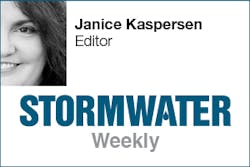
Here’s a quick quiz: which of the 50 states has the highest hidden flood risk? (Scroll down for the answer.)
You might guess Florida—I did—but that low-lying coastal state, in fact, comes in second. And although Florida does have the greatest overall flood risk, hidden risk is something different: it applies to the properties that lie outside FEMA’s designated Special Flood Hazard Areas that still have a moderate or high risk of flooding. This is a significant distinction because properties within the SFHAs must have flood insurance to receive federally backed mortgages. People with property outside the SFHAs might believe, falsely, that they have little or no risk, putting them in unexpected financial peril during the next major storm or hurricane.
So, which state has the highest hidden risk? Arizona. The financial analytics firm CoreLogic has ranked states and determined 68% of homes in Arizona have hidden flood risk, followed by 54% in Florida, 49% for Louisiana, and surprisingly, 40% in North Dakota. In Arizona’s case, it’s the heavily developed Salt River floodplain near Phoenix that accounts for much of the problem.
Even though many of the homeowners whose properties fall into this hidden risk category might want flood insurance, if they understood the threat, their ability to get it in the future is far from certain. On September 8, Congress voted to extend the National Flood Insurance Program for three months to December 8, 2017—that’s this coming Friday. Before that extension, the program was set to expire on September 30. Policies already in place would continue, but no new policies could have been written, which would have prevented many home sales—those that depended on a federally backed mortgage—from going through. The National Association of Realtors, among others, has been pushing hard for the program to be reauthorized.
But the National Flood Insurance Program is deeply in debt—even more so since a series of devastating hurricanes—and its long-term fate is still up in the air. In November, the House of Representatives passed the 21st Century Flood Reform Act, an attempt to reauthorize the program and make it more financially stable. It still needs to be reconciled in the Senate, but it calls for reforms such as denying coverage to properties with repeated flooding.
There’s another way, too, to look at mandatory insurance for at-risk properties. As this article argues, the requirement for homes within the SFHAs to buy insurance is pricing people right out of the market, especially in working-class neighborhoods, and preventing economic recovery in those areas. Flood insurance premiums have been rising by 25% or more per year in some places, and properties in an SFHA must maintain insurance until the mortgage is paid off. “Community leaders say if premiums are allowed to surge unabated, housing markets could crater and take down local economies with them,” according to the article. “Owners will find themselves stuck with properties they can neither sell nor afford to keep. Landlords will be forced to pass the costs of surging premiums on to their tenants.” In one city profiled in the article, annual premiums are running as high as $30,000. The Reform Act passed by the House last month would cap premiums at $10,000—which is still more than many homeowners can afford.
And there is some question about the accuracy of FEMA’s flood maps, even as the agency has been working to update them. A recent study by Rice University found that FEMA’s 100-year floodplain maps failed to capture 75% of flood damages from five serious floods in the Houston area, none of which reached the threshold of a 100-year event. (The study was conducted before Hurricane Harvey hit the area.) An article coming up in the March/April issue of Stormwater magazine will look at that study and the various hydrologic models to help determine flood risk.
About the Author
Janice Kaspersen
Janice Kaspersen is the former editor of Erosion Control and Stormwater magazines.

